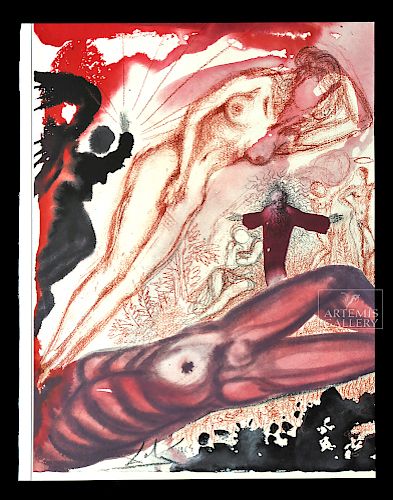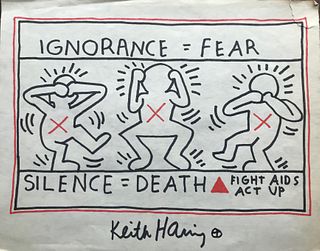Signed Dali Biblia Sacra #6 - Non Est Bonum, 1964
Lot 55i
About Seller
Artemis Fine Arts
686 S Taylor Ave, Ste 106
Louisville, CO 80027
United States
Selling antiquities, ancient and ethnographic art online since 1993, Artemis Gallery specializes in Classical Antiquities (Egyptian, Greek, Roman, Near Eastern), Asian, Pre-Columbian, African / Tribal / Oceanographic art. Our extensive inventory includes pottery, stone, metal, wood, glass and textil...Read more
Categories
Estimate:
$1,500 - $2,500
Absentee vs Live bid
Two ways to bid:
- Leave a max absentee bid and the platform will bid on your behalf up to your maximum bid during the live auction.
- Bid live during the auction and your bids will be submitted real-time to the auctioneer.
Bid Increments
| Price | Bid Increment |
|---|---|
| $0 | $25 |
| $300 | $50 |
| $1,000 | $100 |
| $2,000 | $250 |
| $5,000 | $500 |
| $10,000 | $1,000 |
| $20,000 | $2,500 |
| $50,000 | $5,000 |
| $100,000 | $10,000 |
| $200,000 | $20,000 |
About Auction
By Artemis Fine Arts
May 10, 2018
Set Reminder
2018-05-10 10:00:00
2018-05-10 10:00:00
America/New_York
Bidsquare
Bidsquare : Fine Ethnographic / Asian / Ancient Art
https://www.bidsquare.com/auctions/artemis-gallery/fine-ethnographic-asian-ancient-art-3213
Featuring antiquities from around the world including Pre-Columbian, Tribal, Classical, Asian, so much more! Artemis Fine Arts info@artemisfinearts.com
Featuring antiquities from around the world including Pre-Columbian, Tribal, Classical, Asian, so much more! Artemis Fine Arts info@artemisfinearts.com
- Lot Description
Salvador Dali (Spanish, 1904-1989), Biblia Sacra #6 "Sanctus Hieronymus (Holy Jerome)", mixed technique lithograph in colors from original gouache on heavy laid paper. Signed and dated 1964 in the stone in black on lower left. Lithograph #6 from volume I of Salvador Dali's five volume Biblia Sacra Suite published in Rizzoli, Rome, 1965-1969. This work appears in the Official Catalog of the Graphic Works of Salvador Dali by Albert Field (p. 203). The handmade Japanese rice paper overlay reads, "Non est bonum esse hominem solum: faciamus ei adiutorium similem sibi (It is not good that the man should be alone; I will make him a helper suitable for him) (Genesis, 2)" on the upper left and "Sacramentum hoc magnum est: ego autem dico in Christo et in Ecclesia (This is a great, but I am talking about Christ and the church) (ad Ephesios, 5)" on the lower left. Size: 14.25" W x 19" H (36.2 cm x 48.3 cm) Size: 14.25" W x 19" H (36.2 cm x 48.3 cm)
According to Albert Field's "Official Catalog of the Graphic Works of Salvador Dali" (authorized by Dali), "Rizzoli / New York exhibited the original paintings and the prints side by side. The prints are so like the originals that the only sure way to distinguish one from the other was that the paint on the originals made the surface uneven." (Field, p. 201)
The Biblia Sacra suite, including 105 lithographs on heavy laid paper within five illustrated volumes of the Bible in Vulgate (the late 4th century Latin translation of the Bible that became the Catholic Church's official version of the Bible during the 16th century), was published by Rizzoli Editions, Roma, Italy and is the largest published suite of Dali’s work. The suite was commissioned by Dali’s friend and patron Guiseppe Albaretto, and took six years to complete (1963 to 1969). Believing that Dali had fallen under the influence of Gala, his wife, whom he deemed to be "beyond redemption," Albaretto wanted to give Dali a religious direction, to embrace the Catholic Church. The compositions, replete with rich color and captivating content, showcase Dali's creative interpretations of passages from the Holy Bible – and the imagery is inspired by both Christian iconography and classical mythology. The works also demonstrate Dali’s use of a Surrealist technique which he invented called "bulletism," where a type of antique gun known as an arquebus was loaded with ink-filled capsules, aimed, and fired at blank sheets of paper. Dali then incorportated the resulting patterns and motifs into the suite’s illustrations.
Salvador Domingo Felipe Jacinto Dali i Domenech, Marquis of Dalí de Pubol (May 11, 1904 – January 23, 1989), was a Spanish surrealist artist of Catalan ethnicity born in Figueres, Catalonia, Spain. One of the most famous artists that has ever lived, Dali was a prolific creator working in many mediums such as painting, sculpture, ceramics, jewelry, writing , multi media, photography, and filmmaking to name a few. He had a famously eccentric personality, and with his exceptional skill as a draftsman and his unusually imaginative view of the world, Dali captured the attention of the public wherever his work was displayed. He created his own personal philosophy which he called paranoid critical - a state in which one could simulate delusion while still maintaining one’s sanity - which influenced the Surrealist movement. Dali’s world of tapping into the unconscious using symbolism filled with themes from religion, death, eroticism, and decay has fascinated even those who were not frequent art lovers. Dali was a great showman and loved being adored by his public. But needless to say, he had the talent to sustain his popularity even after his death.
Provenance: private Lucille Lucas collection, Crested Butte, Colorado, USA
All items legal to buy/sell under U.S. Statute covering cultural patrimony Code 2600, CHAPTER 14, and are guaranteed to be as described or your money back.
A Certificate of Authenticity will accompany all winning bids.
We ship worldwide and handle all shipping in-house for your convenience.
#133910This original lithograph in colors is in excellent condition. Signed and dated 1964 in the stone in black on lower left. The overlay shows minor tears/creasing/losses to margins that do not interfere with the text.Condition
- Shipping Info
-
All shipping is handled in-house for your convenience. Your invoice from Artemis Gallery will include shipping calculation instructions. If in doubt, please inquire BEFORE bidding for estimated shipping costs for individual items.
-
- Buyer's Premium



 EUR
EUR CAD
CAD AUD
AUD GBP
GBP MXN
MXN HKD
HKD CNY
CNY MYR
MYR SEK
SEK SGD
SGD CHF
CHF THB
THB














